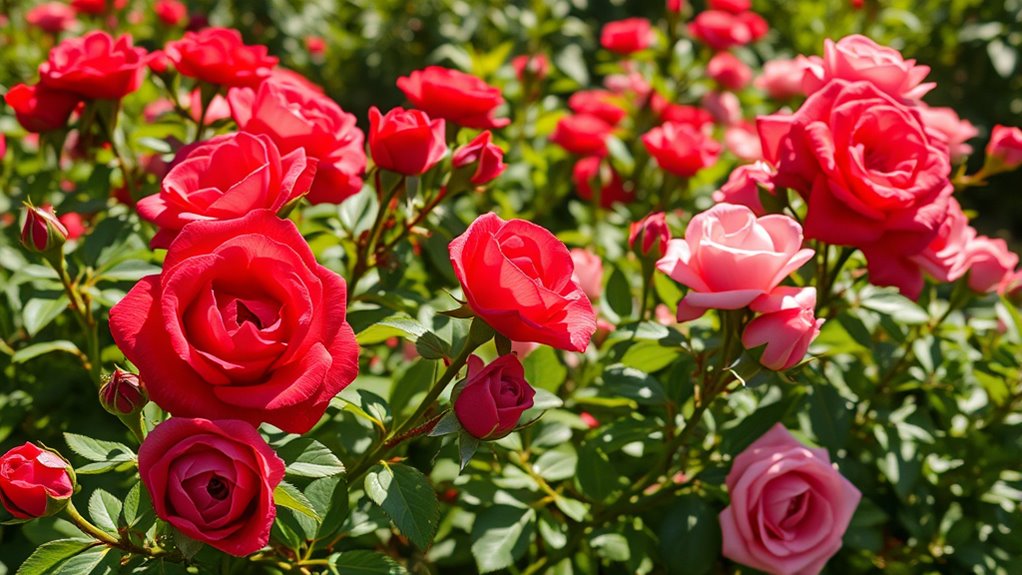To keep your rose garden thriving year-round, prune in early spring to shape plants and remove winter damage, deadhead spent blooms during the season for continuous flowering, and prune again in late fall to eliminate weak or diseased wood. Regularly monitor for pests like aphids and spider mites, removing debris and old blooms to prevent pests and diseases. Mulch in late fall to protect roots and suppress weeds. If you continue exploring, you’ll discover more seasonal tips to maintain a healthy, beautiful rose garden.
Key Takeaways
- Prune roses in early spring to shape plants and remove winter damage, and perform a final prune in late fall.
- Regularly deadhead spent blooms and monitor for pests throughout the growing season to promote continuous flowering.
- Maintain garden hygiene by removing debris and old blooms to prevent pests and disease buildup year-round.
- Mulch in late fall to protect roots, retain moisture, and deter pests during winter.
- Conduct seasonal inspections for pests and disease, adjusting control methods like water sprays or organic treatments accordingly.

Are you ready to keep your rose garden healthy and vibrant year-round? The key lies in understanding proper care routines, especially when it comes to pruning techniques and pest prevention. Regular pruning is essential to shape your roses, promote healthy growth, and prevent disease. You should start by removing any dead, damaged, or diseased wood, cutting back to healthy tissue. When pruning, make clean cuts at a 45-degree angle about a quarter inch above an outward-facing bud. This encourages outward growth, keeping your plant open and well-ventilated. During the growing season, deadhead spent blooms to promote continuous flowering and remove any crossing branches that may rub against each other, creating entry points for pests and diseases.
Pest prevention is an ongoing task that requires vigilance. Keep a close eye on your roses for signs of common pests like aphids, Japanese beetles, and spider mites. Early detection is essential. You can physically remove pests by hand or use a strong stream of water to dislodge them. Applying insecticidal soap or neem oil can also help control infestations without harming beneficial insects. Good garden hygiene plays a big role in pest prevention. Remove fallen leaves, old blooms, and debris around your plants regularly, as they serve as breeding grounds for pests and disease-causing fungi. Mulching around your roses helps retain moisture, suppress weeds, and keeps pests from crawling up the stems. Additionally, understanding the role of color accuracy and how it impacts overall image quality can be beneficial for creating visually appealing garden photos or garden-themed displays.
Timing your pruning and pest prevention efforts is critical. In early spring, before new growth begins, prune your roses to shape the plant and remove any winter damage. This is also when you should inspect for pests and take preventive measures, applying treatments if necessary. During the growing season, continue deadheading and monitoring for pests weekly. In late fall, once the roses have finished blooming and the weather cools, give your plants a final prune to remove any weak or diseased wood and prepare them for winter dormancy. Applying a layer of mulch around the base of your roses in late fall protects roots from freezing temperatures and discourages pests seeking shelter.
Frequently Asked Questions
Can I Grow Roses Indoors Year-Round?
Yes, you can grow roses indoors year-round if you provide enough indoor sunlight and choose the right container. Place your roses where they’ll get at least 6 hours of direct sunlight daily, or supplement with grow lights. Use a well-draining container with good airflow to prevent diseases. Regular watering, pruning, and fertilizing will keep your indoor roses healthy and thriving all year long.
What Are Natural Remedies for Common Rose Pests?
You can manage common rose pests naturally by using organic pest control methods. Try introducing companion planting, like marigolds or garlic, to repel pests. You can also spray your roses with neem oil or insecticidal soap, which are safe and effective. Regularly inspect your plants and remove any affected leaves. These natural remedies help keep pests at bay while supporting a healthy, thriving rose garden.
How Do I Prevent Rose Diseases in Humid Climates?
Your rose garden is under attack like a fortress besieged! To prevent diseases in humid climates, choose disease-resistant cultivars and implement humidity control techniques. Improve air circulation by spacing plants properly and prune regularly. Mulch to prevent soil splash and reduce moisture buildup. Keep foliage dry, especially in early mornings, and avoid overhead watering. These strategies will help you keep your roses healthy and vibrant, even in the most humid environments.
Are There Drought-Tolerant Rose Varieties?
You’ll find plenty of drought-resistant varieties that thrive with less water, making them perfect for water-wise cultivation. Look for roses labeled as drought tolerant or drought resistant, which are bred to withstand dry conditions. These varieties typically require less frequent watering and are more resilient during droughts. By choosing these, you can enjoy a beautiful rose garden while conserving water and reducing maintenance, especially in areas prone to drought.
How Do I Prune Roses for Reblooming?
Imagine your roses bursting into new blooms like a fireworks display. To encourage reblooming, you need to prune carefully. Use sharp pruning tools to deadhead techniques—removing faded flowers just above a set of healthy leaves or buds. This stimulates fresh growth and more blossoms. Regular pruning keeps your roses healthy, vibrant, and ready to put on a stunning show again and again.
Conclusion
Think of your rose garden as a living symphony, each season playing its essential part. With your attentive care, you’re the conductor guiding the blooms through their yearly performance. When you nurture, prune, and feed them, you’re ensuring every note rings clear and vibrant. Keep up your rhythm, and your garden will flourish like a beautiful melody—timeless and enchanting, year after year. Your dedication turns a simple patch of soil into a stunning masterpiece.









